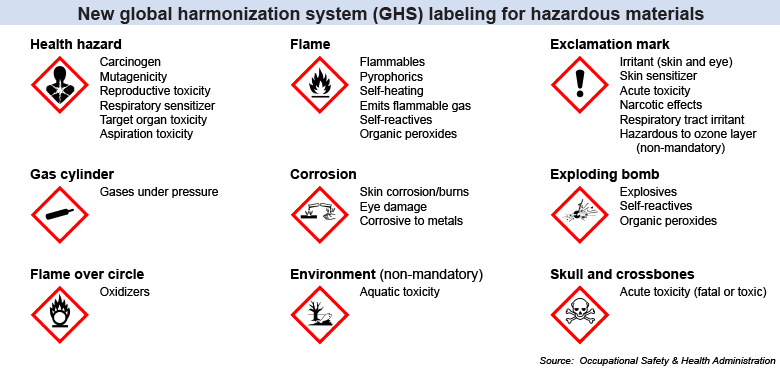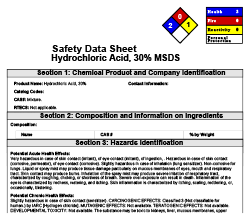|
 The Globally Harmonized System of Classification and Labeling of Chemicals (GHS) is a new, worldwide standard for identifying and labeling hazards on the data sheets and packaging for chemicals. There are nine different categories of hazards in the GHS, as illustrated above. The GHS standard allows people who handle these materials to have both illustrations and text that allow rapid identification of the hazards associated with the substance. These regulations provide safety guidelines that you should always follow when handling the chemical.
The Globally Harmonized System of Classification and Labeling of Chemicals (GHS) is a new, worldwide standard for identifying and labeling hazards on the data sheets and packaging for chemicals. There are nine different categories of hazards in the GHS, as illustrated above. The GHS standard allows people who handle these materials to have both illustrations and text that allow rapid identification of the hazards associated with the substance. These regulations provide safety guidelines that you should always follow when handling the chemical.
|
 Products should be labeled with the product name, pictograms of the hazards, appropriate signal words, hazard statements, precautionary statements, and supplier information. Precautionary statements come in four categories: prevention, response, storage, and disposal. Both the packaging box and the individual products should be labeled. If you pour out some of the chemical and put it into another container (such as a spray bottle for a cleaning agent), then you should place the label onto the new container, too.
Products should be labeled with the product name, pictograms of the hazards, appropriate signal words, hazard statements, precautionary statements, and supplier information. Precautionary statements come in four categories: prevention, response, storage, and disposal. Both the packaging box and the individual products should be labeled. If you pour out some of the chemical and put it into another container (such as a spray bottle for a cleaning agent), then you should place the label onto the new container, too.
|
 A safety data sheet (SDS)—previously called a material safety data sheet (MSDS)—is an important document to provide workers with clear instructions for the safe handling, storage, and disposal of a chemical. A SDS provides workers with information on first aid, toxicity, reactivity, flammability, protective equipment, and spill-handling procedures for the chemical. Schools and research facilities should keep these forms in a labeled binder that is easily accessible in case of an accident. When you work with chemicals, make sure you know where these forms are kept and be familiar with their contents for any chemicals you work with.
A safety data sheet (SDS)—previously called a material safety data sheet (MSDS)—is an important document to provide workers with clear instructions for the safe handling, storage, and disposal of a chemical. A SDS provides workers with information on first aid, toxicity, reactivity, flammability, protective equipment, and spill-handling procedures for the chemical. Schools and research facilities should keep these forms in a labeled binder that is easily accessible in case of an accident. When you work with chemicals, make sure you know where these forms are kept and be familiar with their contents for any chemicals you work with.
 |
In the past, chemical products manufacturers were required to provided safety data sheets under a broad set of performance guidelines; the format of these sheets, however, was not uniform across the industry. Recent regulations require that every SDS follows the same format containing 16 sections: - product and company identification,
- hazard identification,
- composition/information on ingredients,
- first-aid measures,
- firefighting measures,
- accidental release measures,
- handling and storage,
- exposure controls/personal protection,
- physical and chemical properties,
- stability and reactivity,
- toxicological information,
- ecological information,
- disposal considerations,
- transport information,
- regulatory information, and
- other information.
These data sheets provide safety guidelines for you to follow that will keep you and the people around you safe when handling chemicals. The sheets also give clear information for the identification and classification of hazardous wastes for purposes of their proper disposal. It is important to follow the guidelines every time you handle a chemical so that you can master these safety procedures! 
|
| |
|

